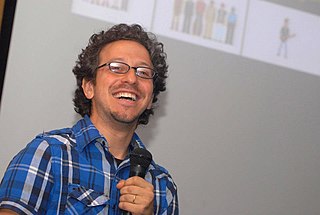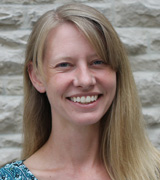Related Research Articles

The temporal lobe is one of the four major lobes of the cerebral cortex in the brain of mammals. The temporal lobe is located beneath the lateral fissure on both cerebral hemispheres of the mammalian brain.

The auditory system is the sensory system for the sense of hearing. It includes both the sensory organs and the auditory parts of the sensory system.

Sensory neurons, also known as afferent neurons, are neurons in the nervous system, that convert a specific type of stimulus, via their receptors, into action potentials or graded receptor potentials. This process is called sensory transduction. The cell bodies of the sensory neurons are located in the dorsal root ganglia of the spinal cord.

The auditory cortex is the part of the temporal lobe that processes auditory information in humans and many other vertebrates. It is a part of the auditory system, performing basic and higher functions in hearing, such as possible relations to language switching. It is located bilaterally, roughly at the upper sides of the temporal lobes – in humans, curving down and onto the medial surface, on the superior temporal plane, within the lateral sulcus and comprising parts of the transverse temporal gyri, and the superior temporal gyrus, including the planum polare and planum temporale.

Figure–ground organization is a type of perceptual grouping that is a vital necessity for recognizing objects through vision. In Gestalt psychology it is known as identifying a figure from the background. For example, black words on a printed paper are seen as the "figure", and the white sheet as the "background".

In psycholinguistics, language processing refers to the way humans use words to communicate ideas and feelings, and how such communications are processed and understood. Language processing is considered to be a uniquely human ability that is not produced with the same grammatical understanding or systematicity in even human's closest primate relatives.
In developmental psychology and developmental biology, a critical period is a maturational stage in the lifespan of an organism during which the nervous system is especially sensitive to certain environmental stimuli. If, for some reason, the organism does not receive the appropriate stimulus during this "critical period" to learn a given skill or trait, it may be difficult, ultimately less successful, or even impossible, to develop certain associated functions later in life. Functions that are indispensable to an organism's survival, such as vision, are particularly likely to develop during critical periods. "Critical period" also relates to the ability to acquire one's first language. Researchers found that people who passed the "critical period" would not acquire their first language fluently.
Neuroplasticity, also known as neural plasticity or just plasticity, is the ability of neural networks in the brain to change through growth and reorganization. Neuroplasticity refers to the brain's ability to reorganize and rewire its neural connections, enabling it to adapt and function in ways that differ from its prior state. This process can occur in response to learning new skills, experiencing environmental changes, recovering from injuries, or adapting to sensory or cognitive deficits. Such adaptability highlights the dynamic and ever-evolving nature of the brain, even into adulthood. These changes range from individual neuron pathways making new connections, to systematic adjustments like cortical remapping or neural oscillation. Other forms of neuroplasticity include homologous area adaptation, cross modal reassignment, map expansion, and compensatory masquerade. Examples of neuroplasticity include circuit and network changes that result from learning a new ability, information acquisition, environmental influences, pregnancy, caloric intake, practice/training, and psychological stress.
An auditory hallucination, or paracusia, is a form of hallucination that involves perceiving sounds without auditory stimulus. While experiencing an auditory hallucination, the affected person hears a sound or sounds that did not come from the natural environment.
Auditory processing disorder (APD), rarely known as King-Kopetzky syndrome, is a neurodevelopmental disorder affecting the way the brain processes sounds. Individuals with APD usually have normal structure and function of the ear, but cannot process the information they hear in the same way as others do, which leads to difficulties in recognizing and interpreting sounds, especially the sounds composing speech. It is thought that these difficulties arise from dysfunction in the central nervous system.
Misophonia is a disorder of decreased tolerance to specific sounds or their associated stimuli, or cues. These cues, known as "triggers", are experienced as unpleasant or distressing and tend to evoke strong negative emotional, physiological, and behavioral responses not seen in most other people. Misophonia and the behaviors that people with misophonia often use to cope with it can adversely affect the ability to achieve life goals, communicate effectively, and enjoy social situations. Originating within the field of audiology in 2001, the condition remained largely undescribed in the clinical and research literature until 2013, when a group of psychiatrists at Amsterdam University Medical Center published a detailed misophonia case series and proposed the condition as a "new psychiatric disorder" with defined diagnostic criteria. At present, misophonia is not listed as a diagnosable condition in the DSM-5-TR, ICD-11, or any similar manual, making it difficult for most people with the condition to receive official clinical diagnoses of misophonia or billable medical services. An international panel of misophonia experts has rigorously established a consensus definition of misophonia as a medical condition, and since its initial publication in 2022, this definition has been widely adopted by clinicians and researchers studying the disorder.

Isabelle Peretz is a professor of psychology at the University of Montreal, holding a Canada Research Chair and Casavant Chair in neurocognition of music. She specializes in music cognition, focusing on congenital and acquired musical disorders (amusia) and on the cognitive and biological foundations of music processing in general.

Helen J. Neville was a Canadian psychologist and neuroscientist known internationally for her research in the field of human brain development.

PNU-282,987 is a drug that acts as a potent and selective agonist for the α7 subtype of neural nicotinic acetylcholine receptors. In animal studies, it shows nootropic effects, and derivatives may be useful in the treatment of schizophrenia, although PNU-282,987 is not suitable for use in humans because of excessive inhibition of the hERG antitarget. PNU-282987 has been shown to initiate signaling that leads to adult neurogeneis in mammals.

The British Methodist Episcopal (BME) Church, Salem Chapel was founded in 1820 by African-American freedom seekers in St. Catharines, Ontario. It is located at 92 Geneva St., in the heart of Old St. Catharines. The church is a valued historical site due to its design, and its important associations with abolitionist activity.
Monita Chatterjee is an auditory scientist and the Director of the Auditory Prostheses & Perception Laboratory at Boys Town National Research Hospital. She investigates the basic mechanisms underlying auditory processing by cochlear implant listeners.

Tristan Bekinschtein is biologist, Master in Neurophysiology and PhD in neuroscience, Buenos Aires University. He is a university lecturer and Turing Fellow at Cambridge University. Dr. Bekinschtein is primarily known for his work on variable states of consciousness and auditory feedback. He presently runs the Consciousness and Cognition Laboratory at Cambridge University.

Sheena Josselyn is a Canadian neuroscientist and a full professor of psychology and physiology at Hospital for Sick Children and The University of Toronto. Josselyn studies the neural basis of memory, specifically how the brain forms and stores memories in rodent models. She has made critical contributions to the field of Neuronal Memory Allocation and the study of engrams.

Jessica Adrienne Grahn is an American music neuroscientist. She is the director of the Human Cognitive and Sensorimotor Core of the University of Western Ontario's Brain and Mind Institute. During the COVID-19 pandemic, Grahn was named to the Royal Society of Canada's College of New Scholars, Artists and Scientists.
Caroline Palmer is the Canada Research Chair in Cognitive Neuroscience of Performance and Professor in the Department of Psychology at McGill University in Montreal, Canada. She is also an Associate Faculty Member in the Schulich School of Music at McGill. Her research in cognitive science addresses the behavioural and neural foundations that make it possible for people to produce auditory sequences such as playing a musical instrument or speaking. Palmer has developed and empirically tested computational models of how people perceive and produce auditory sequences, and how they coordinate their actions with others.
References
- ↑ "Benjamin Zendel". gc.ca. Retrieved March 12, 2017.
- ↑ "Benjamin Zendel". mun.ca. Retrieved March 12, 2017.